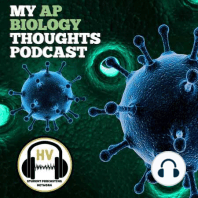7 min listen
Proteins Structure and Function
ratings:
Length:
5 minutes
Released:
Apr 6, 2021
Format:
Podcast episode
Description
My AP Biology ThoughtsUnit 1 Episode #44Welcome to My AP Biology Thoughts podcast, my name is CJ and I am your host for episode 44 called Unit 1 Ecology: Proteins structure and function. Today we will be discussing everything about proteins.Segment 1: Introduction to ProteinsYou may be asking, what is a protein? Well, a protein is a macromolecule that helps us with muscle growth and development. It is most commonly found in animals and we even produce our own proteins. Such macromolecules are created in the cells of an organism. When it comes to what they look like, the simple answer is, it depends. In simple biology, they mainly talk about them in their primary structure. Which is it’s simplest and most basic structure. It consists of amino acids in a singular line. These amino acids are made up of a centralized alpha carbon, with a amino group, carboxyl group, a singular hydrogen and a variant group stemming from it. Digging deeper into each group, we see that an amino group consists of one Nitrogen with three hydrogens. The carboxyl group has a carbon that is bonded to an oxygen and double bonded with another oxygen. The variant group is anything that defines that amino acid. Any variant of atoms can go here and that is what makes each amino acid unique and different. Now in addition to their primary structure, there is the secondary structure (which is a single helix) tertiary structure and the quaternary structure. All of them are just multiples of the previous structure and each structure plays a different role. Just like how, a quaternary structure is made up of multiple polypeptide chains that connect and form one macromolecule. Now they bond to each other in a specific way. Looking at the primary structure, each group is connected using a peptide bond. This is a covalent bond as a result of losing water. So that means it is a dehydration synthesis reaction. These bonds link the carboxyl group from one amino acid to the amino group of another. The result of this bond is the compound being polar and having a nitrogen and carbon backbone. These bonds could range from one to 1000 different amino acids. The huge giveaway to identifying a protein is the carboxyl group, so look for a carbon double bonded with an oxygen and single bonded with another. And second, identify the amino group, along with the alpha carbon, these are keys to look for when identifying a protein. Segment 2: Example of ProteinsProteins and amino acids are found in everything living. They range from different functions such as transportation, structural, defense, storage, enzymes and hormones. For example, in animals, we have living tissue that connects all of our bonds, this is called collagen. It is very strong and is composed of 3 polypeptide chains that are intertwined to form the strong protein that keeps us together. More examples include hemoglobin, keratin, pepsin, insulin and albumin. As you can see, these proteins are what keep us together, they are what we are made of. However, in us, there are extremely useful proteins called enzymes. Enzymes break down compounds into simpler molecules so our body can process them. Enzymes reduce the amount of energy needed for these compounds to break down. They fit into them like a lock and key, while connected, the enzyme dissolves the compound. The body uses the remains for easy energy. Segment 3: Digging Deeper into ProteinsLooking at this, we see that proteins are quintessential for life. Animal or not, every living organism has it, and every living...
Released:
Apr 6, 2021
Format:
Podcast episode
Titles in the series (100)
Natural Selection Mechanism by My AP Biology Thoughts
